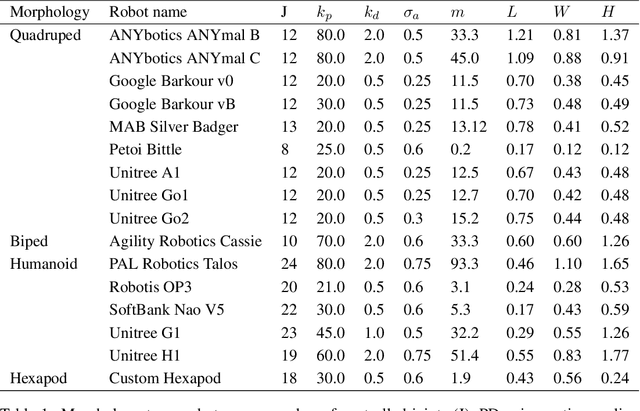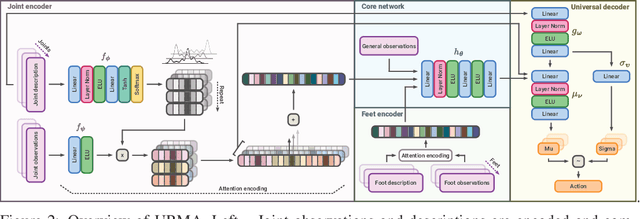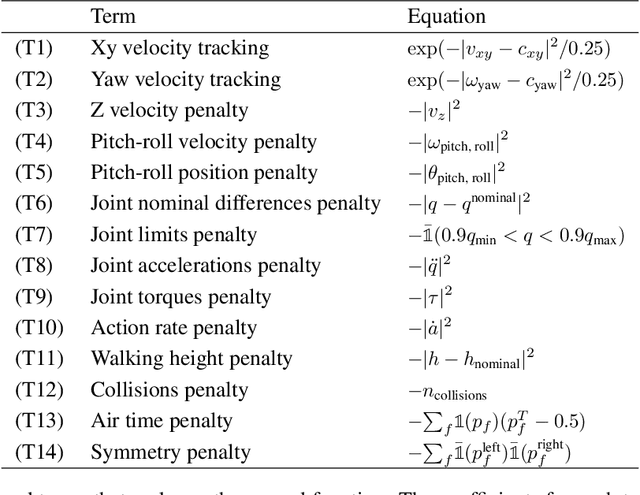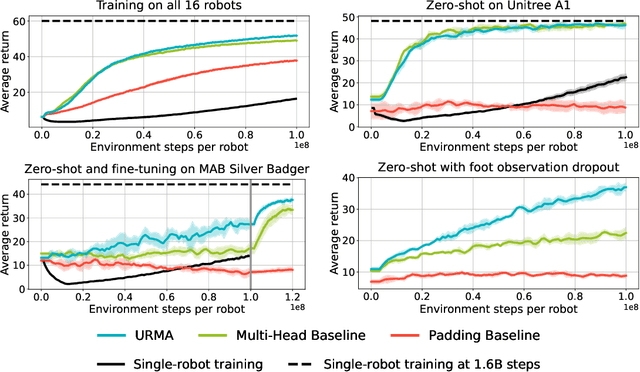Nico Bohlinger
Gait in Eight: Efficient On-Robot Learning for Omnidirectional Quadruped Locomotion
Mar 11, 2025Abstract:On-robot Reinforcement Learning is a promising approach to train embodiment-aware policies for legged robots. However, the computational constraints of real-time learning on robots pose a significant challenge. We present a framework for efficiently learning quadruped locomotion in just 8 minutes of raw real-time training utilizing the sample efficiency and minimal computational overhead of the new off-policy algorithm CrossQ. We investigate two control architectures: Predicting joint target positions for agile, high-speed locomotion and Central Pattern Generators for stable, natural gaits. While prior work focused on learning simple forward gaits, our framework extends on-robot learning to omnidirectional locomotion. We demonstrate the robustness of our approach in different indoor and outdoor environments.
Massively Scaling Explicit Policy-conditioned Value Functions
Feb 17, 2025Abstract:We introduce a scaling strategy for Explicit Policy-Conditioned Value Functions (EPVFs) that significantly improves performance on challenging continuous-control tasks. EPVFs learn a value function V({\theta}) that is explicitly conditioned on the policy parameters, enabling direct gradient-based updates to the parameters of any policy. However, EPVFs at scale struggle with unrestricted parameter growth and efficient exploration in the policy parameter space. To address these issues, we utilize massive parallelization with GPU-based simulators, big batch sizes, weight clipping and scaled peturbations. Our results show that EPVFs can be scaled to solve complex tasks, such as a custom Ant environment, and can compete with state-of-the-art Deep Reinforcement Learning (DRL) baselines like Proximal Policy Optimization (PPO) and Soft Actor-Critic (SAC). We further explore action-based policy parameter representations from previous work and specialized neural network architectures to efficiently handle weight-space features, which have not been used in the context of DRL before.
One Policy to Run Them All: an End-to-end Learning Approach to Multi-Embodiment Locomotion
Sep 10, 2024



Abstract:Deep Reinforcement Learning techniques are achieving state-of-the-art results in robust legged locomotion. While there exists a wide variety of legged platforms such as quadruped, humanoids, and hexapods, the field is still missing a single learning framework that can control all these different embodiments easily and effectively and possibly transfer, zero or few-shot, to unseen robot embodiments. We introduce URMA, the Unified Robot Morphology Architecture, to close this gap. Our framework brings the end-to-end Multi-Task Reinforcement Learning approach to the realm of legged robots, enabling the learned policy to control any type of robot morphology. The key idea of our method is to allow the network to learn an abstract locomotion controller that can be seamlessly shared between embodiments thanks to our morphology-agnostic encoders and decoders. This flexible architecture can be seen as a potential first step in building a foundation model for legged robot locomotion. Our experiments show that URMA can learn a locomotion policy on multiple embodiments that can be easily transferred to unseen robot platforms in simulation and the real world.
RL-X: A Deep Reinforcement Learning Library for RoboCup
Oct 20, 2023Abstract:This paper presents the new Deep Reinforcement Learning (DRL) library RL-X and its application to the RoboCup Soccer Simulation 3D League and classic DRL benchmarks. RL-X provides a flexible and easy-to-extend codebase with self-contained single directory algorithms. Through the fast JAX-based implementations, RL-X can reach up to 4.5x speedups compared to well-known frameworks like Stable-Baselines3.
 Add to Chrome
Add to Chrome Add to Firefox
Add to Firefox Add to Edge
Add to Edge